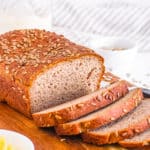Fluffy Homemade Buckwheat Bread (Vegan, Gluten-Free!)
Even first-time bread bakers can successfully make my soft fluffy buckwheat bread with very little effort. With just a few simple pantry ingredients, you’ll get a loaf with a delicious nutty flavor that’s packed with nutrients and is naturally vegan. It's perfect for anyone looking for a healthy, easy bread recipe to make at home. Plus, you can easily make this unbelievable buckwheat bread gluten free too!
Servings: 16 slices
Calories: 145kcal
Ingredients
- 2 tbsp flaxseed meal
- 7 tbsp water
- 1¾ cup all purpose flour or 1:1 gluten free flour made for yeast bread recipes (with xanthan gum added)
- ½ cup buckwheat flour
- ¼ cup psyllium husk powder
- 1 tsp baking powder
- 2¼ tsp instant yeast
- 2 tbsp coconut sugar
- ½ tsp salt
- ⅓ cup light olive oil
- 1 tsp apple cider vinegar
- 1½ cups unsweetened almond milk, warm
- ¼ cup sunflower seeds
Instructions
- Line a loaf pan with parchment paper. Set aside.
- In a small mixing bowl mix the flaxseed and water, set aside for 5 minutes to allow it to become a gel like substance.
- In the mixing bowl of a stand mixer whisk together the flours, psyllium husk powder, baking powder, yeast, sugar and salt.
- Add the remaining ingredients and beat until smooth. (Mixture will be sticky.)
- Place the batter into the prepared tin, spread the batter with a wet spatula. Sprinkle with seeds, cover and allow it to sit in a warm place for 45-60 minutes to double in size.
- Preheat the oven to 350 degrees F / 176 C.
- When the dough has risen remove the cover and place in the oven to cook for 45-50 minutes. The bread should be ready when it sounds hollow when tapped and the outside is crusty.
- Allow the dough to cool completely on a cooling rack before slicing into 16-18 slices.
- Bread will remain fresh for up to 3 days when stored in an airtight container in the fridge.
Notes
- Sliced bread can be frozen for up to 2 months
- Make sure to give the bread enough time to rise, this will help ensure a fluffy soft texture
- Line your loaf pan with parchment paper before adding the batter to prevent the bread from sticking. This also helps in achieving a nice, clean crust.
- Avoid Dense Flour Substitutes: Not all flours can be substituted in this recipe. Dense flours like oat flour or millet flour should be avoided in buckwheat bread recipes as they can weigh down the dough, resulting in really heavy compact bread.
- Use a Serrated Knife: I use a serrated knife to slice the bread after it cools. A regular knife can compress the bread, making it flat and less appealing. A serrated knife glides through the loaf without squishing it.
- No Need To Bloom The Yeast: Even though this is a buckwheat flour bread recipe with yeast, there’s no need to bloom it (which involves dissolving it in warm water before adding it to the dough). Since my recipe uses instant yeast, you can simply mix it directly into the dry ingredients and it will work.
- Use A Wet Spatula: When transferring the dough to the loaf pan, I use a wet spatula to spread it evenly. The water on the spatula prevents the sticky dough from clinging to the tool.
- Cool Completely On A Wire Rack: Once baked, I let the loaf cool completely on a wire rack. Cooling on a rack allows air to circulate around the bread, preventing the bottom from becoming soggy.
- To make this bread gluten free, substitute the all purpose flour with your favorite gluten free flour blend.
Nutrition
Serving: 1slice | Calories: 145kcal | Carbohydrates: 19g | Protein: 3g | Fat: 7g | Saturated Fat: 1g | Polyunsaturated Fat: 1g | Monounsaturated Fat: 4g | Sodium: 109mg | Potassium: 99mg | Fiber: 5g | Sugar: 1g
